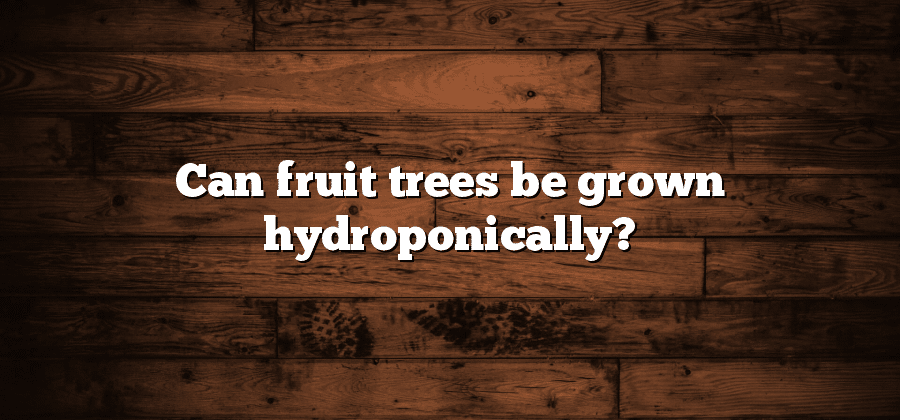Advantages of Hydroponic Fruit Tree Cultivation
Hydroponic fruit tree cultivation offers numerous advantages over traditional soil-based methods. Firstly, hydroponics allows for greater control over the growing environment. By providing the exact amount of water, nutrients, and light necessary for optimal growth, hydroponic systems eliminate the risk of under or over-watering, nutrient deficiencies, or insufficient sunlight. This precise control results in healthier and more productive fruit trees.
Additionally, hydroponic fruit tree cultivation can be practiced in any location, regardless of the availability of arable land. This is especially beneficial in urban areas where space for traditional farming is limited. Hydroponic systems can be set up in small spaces, such as balconies or rooftops, making it possible to grow fruit trees in the heart of the city. Moreover, hydroponics eliminates the need for heavy machinery, reducing the environmental impact associated with traditional farming practices. Overall, the advantages of hydroponic fruit tree cultivation make it an attractive option for farmers and gardeners looking to optimize their yields and contribute to sustainable agriculture.
Suitable Fruit Tree Varieties for Hydroponics
When it comes to growing fruit trees hydroponically, not all varieties are created equal. Certain fruit tree varieties have proven to be more successful in hydroponic systems than others. It is important to carefully consider the suitability of different varieties before embarking on your hydroponic fruit tree cultivation journey.
One key factor to consider is the size of the fruit tree variety. Compact or dwarf varieties are often better suited for hydroponic cultivation due to their smaller size and ability to adapt to limited root space. These varieties also tend to have shorter maturation periods, allowing for quicker and more efficient crop production. Additionally, disease resistance should be taken into account when selecting suitable fruit tree varieties for hydroponics, as this can help minimize the risk of infections and ensure a healthier crop overall.
Essential Nutrients for Hydroponic Fruit Trees
Hydroponic fruit tree cultivation requires careful attention to the essential nutrients that these plants need to thrive. While traditional soil-based fruit trees can access nutrients naturally present in the ground, hydroponic systems rely on nutrient solutions to provide everything the plants need. The primary macronutrients required by hydroponic fruit trees are nitrogen, phosphorus, and potassium. Nitrogen is essential for leaf and stem growth, phosphorus promotes root development and flowering, and potassium aids in overall plant health and disease resistance. In addition to these macronutrients, hydroponic fruit trees also require a range of micronutrients, including calcium, magnesium, and iron, to name a few. These nutrients are typically provided through specially formulated hydroponic nutrient solutions, which can be tailored to the specific needs of different fruit tree varieties.
Proper nutrient management is crucial in hydroponic fruit tree cultivation. It is essential to monitor nutrient levels regularly to ensure that plants are receiving the correct balance of nutrients. Imbalances can lead to nutrient deficiencies or toxicity, which can negatively impact plant growth and fruit production. Nutrient solutions should be mixed according to manufacturer guidelines or expert recommendations, taking into account the type of fruit tree being grown and its growth stage. Additionally, pH levels of the nutrient solution need to be monitored and adjusted as necessary, as this can influence nutrient uptake by the plants. Overall, providing the correct balance of essential nutrients is essential for healthy, vigorous hydroponic fruit trees, leading to optimal yields and quality fruits.
Optimal Growing Conditions for Hydroponic Fruit Trees
For successful hydroponic fruit tree cultivation, providing the optimal growing conditions is crucial. Firstly, it is important to ensure that the temperature and humidity levels are carefully regulated. Fruit trees thrive in specific temperature ranges, typically between 60 to 80 degrees Fahrenheit. Consistency is key, as fluctuations in temperature can negatively impact growth and fruit production. Maintaining optimal humidity levels, usually around 50 to 70 percent, is also vital to prevent issues such as mold and disease.
In addition to temperature and humidity, lighting plays a crucial role in the growth and development of hydroponic fruit trees. Adequate and appropriate lighting is needed to provide the energy for photosynthesis, which is essential for plant growth. LED grow lights are commonly used in hydroponics as they can be tailored to emit the specific light spectrum required by fruit trees. The duration and intensity of light exposure should also be considered, as different varieties of fruit trees have varying light requirements. Striking the right balance between natural and artificial light can greatly impact a fruit tree’s overall health and productivity.
Hydroponic Systems for Fruit Tree Cultivation
When it comes to fruit tree cultivation in a hydroponic system, there are various techniques that can be employed to achieve optimal results. One commonly used method is the nutrient film technique (NFT), which involves circulating a thin film of nutrient solution over the roots of the fruit trees. This allows for constant delivery of essential nutrients and hydration, ensuring healthy growth and development. Another popular hydroponic system for fruit tree cultivation is the deep water culture (DWC) method, where the tree’s roots are immersed in a nutrient-rich solution. This method provides excellent aeration to the roots, promoting vigorous growth and abundant fruit production.
In addition to NFT and DWC, there are other hydroponic systems that can be adapted for fruit tree cultivation. The ebb and flow system, for example, involves periodically flooding the root zone with nutrient solution and then allowing it to drain away. This cyclic irrigation promotes robust root development and nutrient uptake. The aeroponic system, on the other hand, uses a misting technique to deliver nutrients directly to the roots, ensuring maximum nutrient absorption. These different hydroponic systems provide flexibility and options for growers to choose the most suitable method for their specific fruit tree varieties and available resources.






